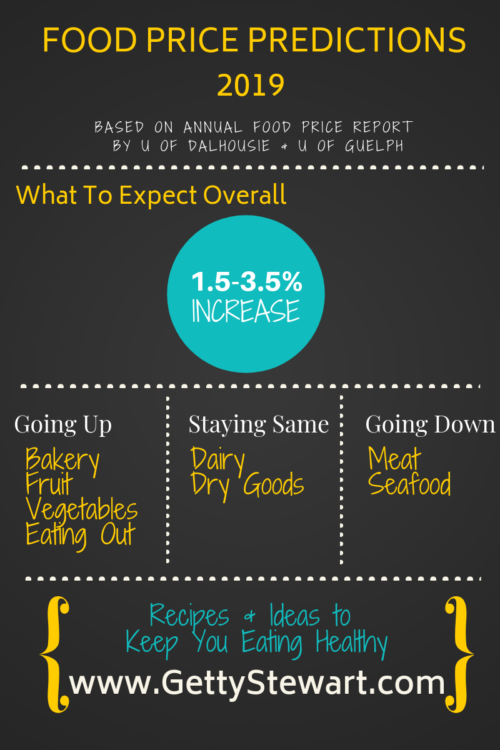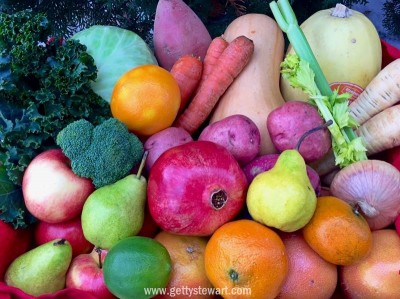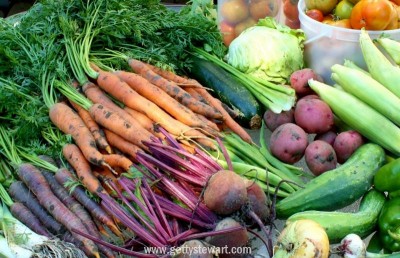|
By: Getty Stewart, P.H.Ec. of www.gettystewart.com For the original post, please click here The Annual Food Price Report predicts rising food prices for 2019. The annual predictions prepared by a joint group from Dalhousie University and the University of Guelph have just been released and given the political and economic uncertainty across our borders, climate change and general eating trends, most of the predictions don’t come as a surprise While an overall increase of 3.5% isn’t a huge surprise, a 1 to 3% decrease in the price of meat is a surprise. When was the last time we heard meat prices are going down?! It just goes to show that our eating behaviours really do impact the market. As a whole, we’re eating and buying less meat and the market is responding. Eating out is going to cost more too, about 4% more. Higher minimum wages, increased veggie prices and tight margins to begin with mean restaurants have to raise prices. It’s unfortunate, but I’m less concerned about this increase than the 4 to 6% increase in the price of vegetables that’s predicted. That’s going to hurt everyone, especially those on low incomes who are already struggling with making healthy food choices due to cost. We’re going to pay more for groceries, especially the food we know we should consume in greatest quantities. Here are a few tips to help stretch the healthy eating food budget. HOW TO EAT WELL WITH RISING FOOD PRICES In addition to smart shopping strategies like taking advantage of sales, coupons and discount grocery stores, here are a few tips to keep you eating healthy despite rising food prices. 1. MAKE A MEAL PLAN AND GROCERY LIST Sadly, we often over buy and inadvertently waste food. In fact, the average Canadian household tosses about $1,500 worth of food every year (University of Guelph Food Waste Research Project). Making a meal plan and grocery list can help. Here’s a handy dandy Weekly Meal Planner and Grocery List that can help you plan your weekly grocery needs. I admit that meal planning isn’t the most fun activity, but it does make a difference and it only takes a few minutes to jot down a few meal ideas. By mid-week, you’ll be patting yourself on the back for how much easier and affordable feeding your family is with a plan. 2. USE A COMBINATION OF FRESH, FROZEN AND CANNED FRUITS AND VEGETABLES Don’t let higher fruit and vegetable prices prevent you from getting your 8-10 servings of Fruits and Veggies. Keep filling Half Your Plate with a variety of delicious, colorful and nutritious produce. To help with the pocket book, shop for frozen and canned fruits and veggies as well as fresh produce. The nutritional content of frozen or canned fruits and vegetables is pretty much equal to and sometimes even better than fresh produce that’s been sitting too long in coolers, transport trucks and warehouses. 3. EAT SEASONALLY You’ll get much more value for your dollar when you buy what’s in season. Check out the great variety of fruits and veggies available during the winter season. Berries, tender fruits and veggies are much more expensive than during their peak season in the summer. It’s tastier and more cost effective to enjoy them fresh during the summer months and eating them canned or frozen in the winter. Leaf lettuce can be pretty expensive in winter months as well. Instead of using leaf lettuce as a base for salads, consider one of these tasty, seasonal winter salads. Broccoli and Edamame Salad with Soy Ginger Dressing Carrot and Apple Salad Classic 3 Bean Salad Orange, Fennel and Celery Salad Southwestern Black Bean, Corn and Pepper Salad Fennel and Red Cabbage Coleslaw Apple and Beet Salad Orange Celery Salad Eating seasonally also gives you great variety throughout the year. During the winter months enjoy pears, apples and citrus fruit along with dark green veggies, winter squash, onions and all sorts of root veggies. 4. EAT YOUR LEFTOVERS We throw out a lot of food and leftovers are a big part of that. We need to make leftovers part of our routine. Add them to your weekly meal plan so you have a plan for what to do with them. 5. CHOOSE BEANS, LENTILS AND OTHER PULSES MORE OFTEN They’re nutritious, delicious, affordable and local. Meat and seafood prices may be going down, but these protein alternatives are still cheaper. Did you know we grow some of the world’s best pulses (dry peas, beans, chickpeas, lentils, etc) right here on the Canadian prairies. Supporting our local agriculture helps our local economy and helps stabilize prices in the long run. The Manitoba Pulse and Soybean Producers agrees, saying pulses are “one of the most environmentally-friendly sources of protein, contributing to sustainable food production by protecting and improving soil and water resources.” According to the United Nations, “pulses are a vital source of plant-based proteins and amino acids for people around the globe and should be eaten as part of a healthy diet to address obesity, as well as to prevent and help manage chronic diseases such as diabetes, coronary conditions and cancer; they are also an important source of plant-based protein for animals.” It’s definitely a good time to add more pulses to our meal planning. Here’s some inspiration and advice on storing and cooking with pulses. And here’s one of my favorite soups in a jar for you to enjoy. 6. USE YOUR FREEZER If you can’t get to your leftovers right away or see that you have food reaching its Best Before Date – throw it in the freezer not the trash! Most prepared food freezes quite well – here’s a quick look at what freezes well and what doesn’t. Foods That Freeze Well baked goods unbaked goods nuts cooked or scrambled eggs and egg whites (not yolks) soups & stews high fat dairy products firm cheese fruits and berries meat (well wrapped) raw vegetables – must be blanched Foods That Don’t Freeze Well egg yolks gelatin based dishes sour cream high moisture vegetables (lettuce, cucumber, etc.) cooked meats not in a sauce or casserole Here’s more info on freezing onions, ginger, wine, and eggs. 7. BE “BEST BEFORE DATE” SAVVY With rising food prices on the way, we gotta make the most of every morsel of food we buy. Do not become a sucker for Best Before dates. Just because food has reached the BBD doesn’t mean you have to throw it out. Here are the most important things you need to know about Best Before Dates in Canada. “Best Before” dates do not guarantee product safety. They provide the manufacturer’s recommendation for the amount of time that an unopened food product under appropriate conditions will keep its freshness, taste and nutritional quality. Think about it, the minute you open your milk jug, the best before date is invalid, so why pay attention to it – use your judgement! By law, “Best Before” dates and proper storage instructions must appear on pre-packaged foods that will keep fresh for 90 days or less, and are packaged at a place other than the retail store from which they are sold. Items that can be stored for 90 days or more (eg. pasta, nuts, canned goods, etc) do not actually require a Best Before date. Sometimes I wonder if manufacturers are encouraging us to toss and rebuy food by adding Best Before dates – what do you think? Best Before does not mean Toxic After. Understand best before dates.TWEET This 8. MAKE SOUP Soup is the ultimate strategy for healthy, affordable eating and rising food prices. Making soup is a creative process that allow you to combine whatever is in the fridge into a delicious, nourishing concoction. Soup was our grandparents way of using whatever was available and making it go a long, long way. We can do the same today. 9. SUPPORT LOCAL GROWERS OR GROW & PRESERVE YOUR OWN FOOD And finally, here’s a more long term strategy – support local growers and food producers or grow your own. I get that not everyone can grow or raise their own food, but by supporting local food producers you’re helping to address some of the bigger issues surrounding where and how our food is produced and how that impacts our local economy, climate change and overall food production practices. This tip isn’t going to save you money right away. It’s a long term investment in the health of you, your family, your local economy and the global environment. 10. KEEP THINGS IN PERSPECTIVE AND THINK ABOUT THOSE LESS FORTUNATE
There’s no doubt rising food prices are going to hurt at the cash register. That never feels good. However, I think it’s important to put food prices in perspective. When I think about the value of food, the resources and processes that go into growing, harvesting, processing, packaging, transporting, warehousing, marketing and selling food, I’m actually amazed at how inexpensive our food truly is. Especially considering how critical it is to our survival. Here’s another way to put rising food prices in perspective. In Canada, the average household spends bout 10-12% of its annual expenditures on food Stats Canada, 2013 . European countries spend between 11 to 15%, countries like Mexico, Poland and Russia spend over 20% of their annual income on food while countries like Indonesia, Pakistan, Nigeria, Kenya, Belarus spend over 40% of their annual income on food (USDA Economic Research Services, 2008). In comparison to others across the world, we’re doing pretty good. We’re also doing pretty good when you consider the percent of income our grandparents spent on food. According to Stats Canada, the average Canadian family spent 28% of food in 1961, and 17% in 2007. The people that will be hardest hit by rising food prices in Canada are those living on low income where the percent of income spent on food is much higher than for those of us with average to high annual incomes. It will also be a hard hit on those living in Northern or remote communities where food prices are considerably higher than in major urban centres. Ensuring everyone has equal access to good quality food is a challenge for all of us. Food security is everyone’s business. As one participant in a recent workshop on Food Security said “No one is food secure unless their neighbours are food secure.”
1 Comment
|
The Ontario Home Economics Association, a self-regulating body of professional Home Economists, promotes high professional standards among its members so that they may assist families and individuals to achieve and maintain a desirable quality of life. Categories
All
Archives
April 2024
|
|
Subscribe to our mailing list
|
|
Unsubscribe from our mailing list
|
Copyright © 2023 Ontario Home Economics Association (OHEA). All Rights Reserved.









 RSS Feed
RSS Feed